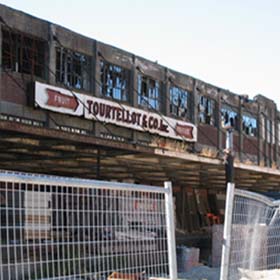
Introduction
The Providence Fruit and Produce Warehouse currently sits vacant, with windows cracked and particleboard nailed over entryways, on a stretch of land behind the Providence Place Mall. What has become a refuge for pigeons and graffiti artists was once a major hub of commerce for the city of Providence...
Description
This long two-story edifice in the Art Moderne style, was designed by local architect Emory W. Ballou of Jenks and Ballou Architects. It is an early example of a reinforced concrete structure, with mushrooming columns evenly spaced thoughout the interior. Cast concrete square columns of austere art-deco detailing (that characterize Art Moderne) with red-brick and glass in-fill repeat for the length of the façade, dividing the building into a number of subunits . The warehouse is lined with front and rear docks for the distribution of goods from trains and trucks. The back of the building continues the pattern of the front with additional brick elevator towers that accompany each subunit. The building was originally 965 feet long, with 71 separate loading bays where workers hauled perishables off of trucks and trains to be sold throughout Southeastern New England. Today 64 of the original bays survive. The Produce Warehouse currently stands vacant, and bares bares signs of neglect, including broken windows, failing canopies , widespread spalling and deterioration of the exterior wall columns and spandrel beams.
History
The building represents a shift of city business toward rail access during the early part of the century. Previously the wholesale produce center of the city was located in Market Square along Canal Street by the Providence River. The various produce wares houses along Market Square were remnants of maritime distribution practices, when merchant ships were brought directly to docks in front of wholesale buildings that dotted the river. By the mid-1920's the practice of bringing goods out into the street from crowded wares houses began to compete with moving automobile traffic.
The Produce Warehouse was conceived then, to ameliorate the traffic congestion of Market Square and attract local and regional wholesale distributors to use the railroad. Completed in 1929, it was financed by the New York, New Haven & Hartford Railroad Company and leased to a conglomerate of local produce dealers called the Providence Fruit and Produce Warehouse Company. Some residents believed the shift of locales meant the loss of "the most colorful spot in the city," while speakers at the Produce Warehouse's opening heralded the new center as the "finest and most efficient distributing unit for perishable foods in the United States." Indeed the new facility had advantages over the old produce hub, with close access to rail tracks a sheltering overhang, and electric lighting. The basement was lined with cork and refrigerated with circulating water.
The Produce Market remained a hub of wholesale produce distribution until its last tenants were evicted in 1998. Up to that time, wholesale perishables could were still distributed to families, universities, hotels, hospitals, neighborhood produce markets and restaurants in the area. However business had declined over the decades, as supermarket chains that ship their goods directly to their own stores, grew into a stronger market force.
In 1980 the State acquired the property where the building stands for $14.1 million, from Amtrak, in order to build an off-ramp to bring shoppers on from I-95 to the Providence Place Mall. At that time, the Produce Warehouse was put under the supervision of the Department of Transportation. Today, only 64 bays survive, as the eastern most bay of the building and the railway tower were amputated as a result of the ramp construction. In 1998 the State evicted remaining businesses and since then the state's Department of Transportation has allowed the building to decay.
Future
Despite the unpromising appearance of the Produce Warehouse in its present state, there is much hope for the rehabilitation of the structure. As a condition of obtaining federal aid to build the ramp, the DOT entered into an agreement giving the Historical Preservation and Heritage Commission, another state agency which was given as say in the management and protection of the property. Also, the produce market is considered a 20th-century historical site, part of a "provisions warehouse historic district" that has been identified by the U.S. Department of the Interior and the Rhode Island Historical Preservation & Heritage Commission which makes it eligible for listing on the National Register of Historic Places. Since 1998, the Produce Warehouse has become an eyesore, however a recent assessment of the building commissioned by the Department of Transportation has demonstrated that the building continues to be structurally sound, and that rehabilitation of the property is possible. Given current development taking place in the area and on adjacent properties, the Produce Warehouse has potential for restoration and reintegration into the urban fabric as bustling hub of activity.
Sources
Books and Reports:
Barbara Sokoloff Associates, Inc. Promenade District Planning Study , 9/8/1999. p. 22
Cady, John Hutchens. Civic and Architectural Development of Providence . Ackerman Standard Press, RI.
Conley, Patrick; Campbell, Paul. Providence: A Pictorial History . Danning Co., VA. 1983.
Providence Preservation Society. "Providence Produce Warehouse Company," Providence Industrial Sites and Commercial Buildings Survey: Final Report 2001-2001.
William D. Warner Architects & Planners, of Exeter. Preliminary Structural Evaluation (Draft): Providence Fruit and Produce Warehouse Company Building, 11/2002
ibid. An Adaptive Reuse Plan for Providence Fruit and Produce Warehouse Building, 3/2003
Providence Journal:
Chivers, C.J.. "Expiration Date January 4 Produce Market Evicted." 12/13/1998: B1
Davis, Karen A., "Saving City History, One Brick at a Time." 12/05/2002
"Produce Dealers Decide on Site." 10/5/1927:24
"Progress Again to Push Picturesque From City Streets." 2/19/1928:F1
"$1,000,000 Produce Terminal Opened." 4/16/1929:1
Smith, Gregory. "Farmer's Market: Save it or Raze it?" 2/5/2003:B1
Websites:












